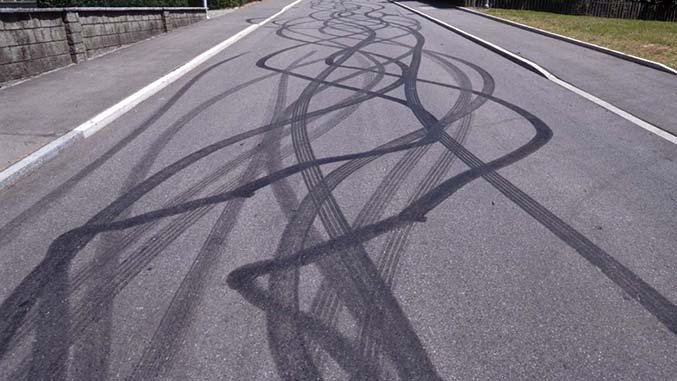Speed Secrets: Physics For Gearheads

|
Randy holds a Ph.D. in mechanical engineering, and for 30 years has been an automotive engineer at General Motors, where he is a technical specialist in noise and vibration (N&V) at their proving ground in Milford, MI. He has published numerous papers on powertrain N&V, and holds three patents. His first assignment at GM was the enviable task of developing Corvettes for minimized “rough road shake.” Randy sent this week's feature article on a Saturday evening, right in the middle of driving his Cayman in a 2-day track event at Putnam Park. So you know that he not only knows the theory, he drives the theory. –Ross A couple of years ago, I finally took my wife, Tara, to the Kentucky Derby. She has always appreciated the strength and beauty of the thoroughbreds and the skill of the jockeys as they manage their race and position their ride. It rained all day, never heavy, but when the Derby ran, the track was officially listed as “sloppy.” During the rain, most everyone was under the stands, trying out the mint juleps. Our son, Aric, had come along, and found that rain doesn’t dampen the mood so much in the infield. And the mud troughs are handy for doing belly slides (fortunately, he came back clean). Under the stands, Tara and I started talking with someone from a large city, and the subject turned to jockeys. In a while he said, “I don’t get the big deal about jockeys. All they do is ride the horse.” I replied with something profound like, “Oh?” Then he said, “Yeah, it’s just like race car drivers. All they do is drive the car!” Back before you could see what went on inside the car (say, in the 1970’s), it was easy to think that the Daytona 500 was a leisurely 200-mph Sunday cruise. From the outside, the cars smoothly tracked around the course, as if on rails. It looked so easy that it made you wonder why anyone ever drifted wide, or spun. Drafting – new back then – was discussed more than driving technique. That changed when I saw video from an in-car camera. This “cruise” around the track involved constant steering corrections of what looked like 30°. It seemed like moving the wheel that much would send the car veering into the wall! Why was the driver so busy? |
Physics explains what happens during those steering corrections. Imagine you are driving a performance car and quickly turn the wheel enough to change the front tires’ steer angle by 1°. For a short time, their slip angle will also change by 1°, and their lateral (cornering) force will change with it, as the figure shows for a specific performance tire. How the car reacts to this correction, by changing its lateral acceleration, depends on how hard you’re already cornering.
If you were originally traveling in a straight line (0° slip and zero lateral force), the figure shows that the 1° correction will increase this tire’s lateral force by 560 pounds. The car responds strongly in a linear way to your steering. That’s where it feels like it’s on rails.
But as you’ve heard, “If everything seems under control, you're just not going fast enough.” To corner harder, the tires must produce a higher lateral force – through having a larger slip angle. How responsive is the car now? If the tire starts off at 3° slip (and producing 1025 pounds of lateral force), the quick 1° correction to 4° produces only a 60-pound increase. Turning the steering wheel has become more like “fine-tuning” the cornering force. And you can feel the tire is “saturating.”
For maximum performance, that’s still not enough. To corner with all the available traction of 1100 pounds, the driver would need to keep the slip angle between four and six degrees, where quick corrections in steering produce almost no change in lateral force. And of course you have to stay on top of it, because too much slip and the traction drops – and the car loses stability. That’s the balancing act the driver performs with those corrections. That’s the art.
I’m sure that in the end, everyone has their own way of joining their driving intuition with the characteristics of the car. What helps me is to imagine what’s going on at the tire patch when I tweak the wheel, how the springs compress when braking or cornering, and how the dampers settle this motion down. But I don’t really think about that when driving, unless I feel something unexpected. Then, either something is wrong or there is something new for me to learn. Maybe it’s a sign that something needs to be adjusted or replaced.
I’ll never be a race driver, but I have enough experience to appreciate what they do. And I can still appreciate and enjoy something the guy at the Derby never will: rolling the power on exiting a curve while unwinding the wheel, tracking out the last ten feet or so while already pointed down the straight. Plus, I can visualize the combined physics of the tires, the engine, and the gearing making it all happen. It brings it all together.
For me, it doesn’t get any better than that.
– Randy Beikmann
Web: PhysicsForGearheads
Facebook: Facebook.com/PhysicsForGearheads



















